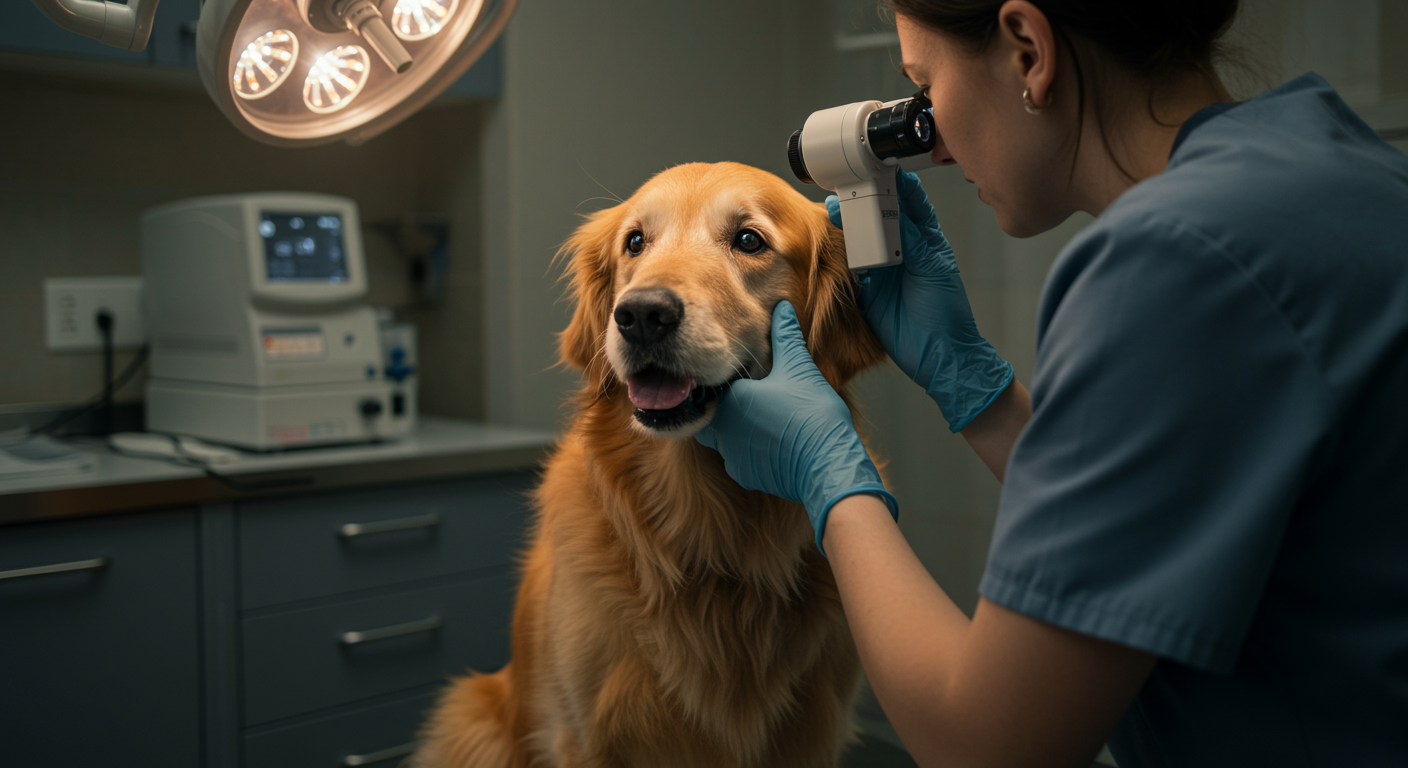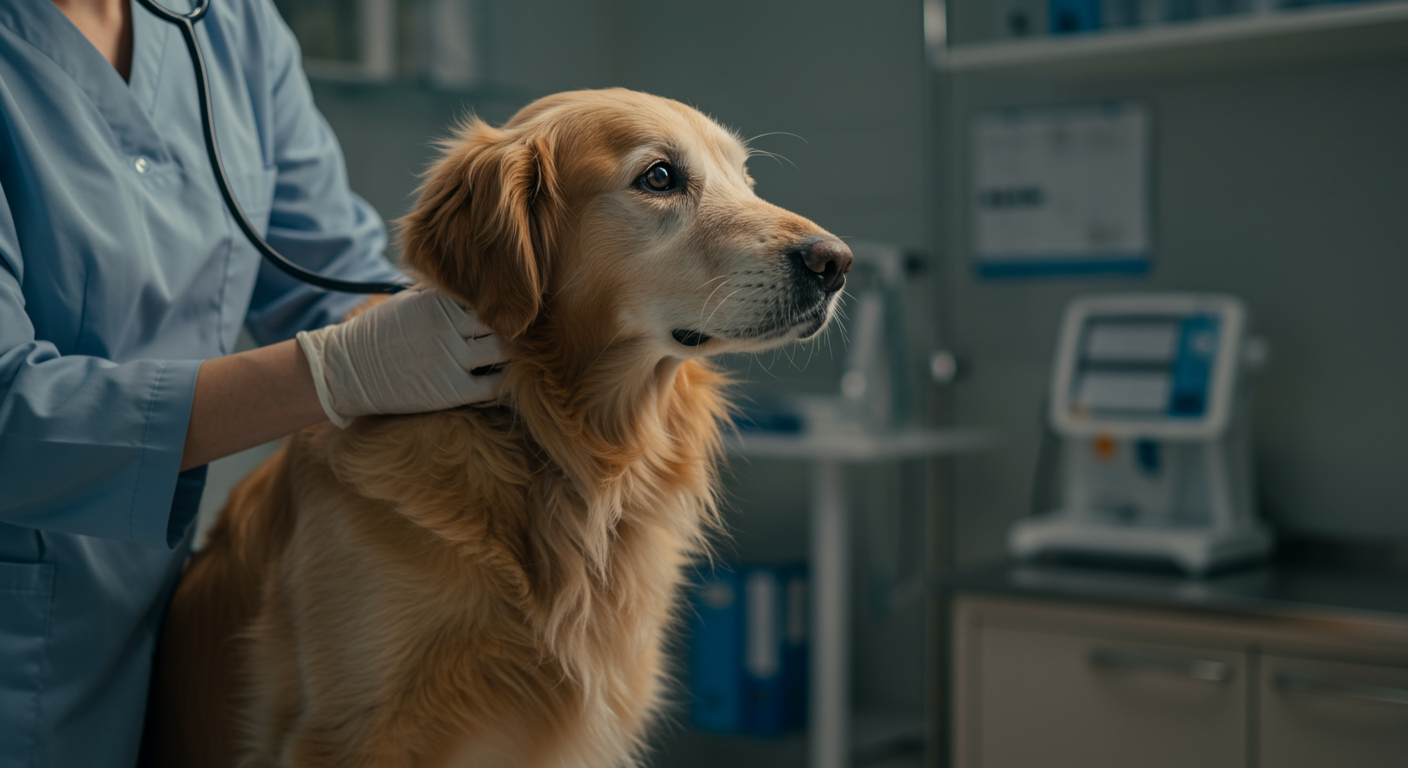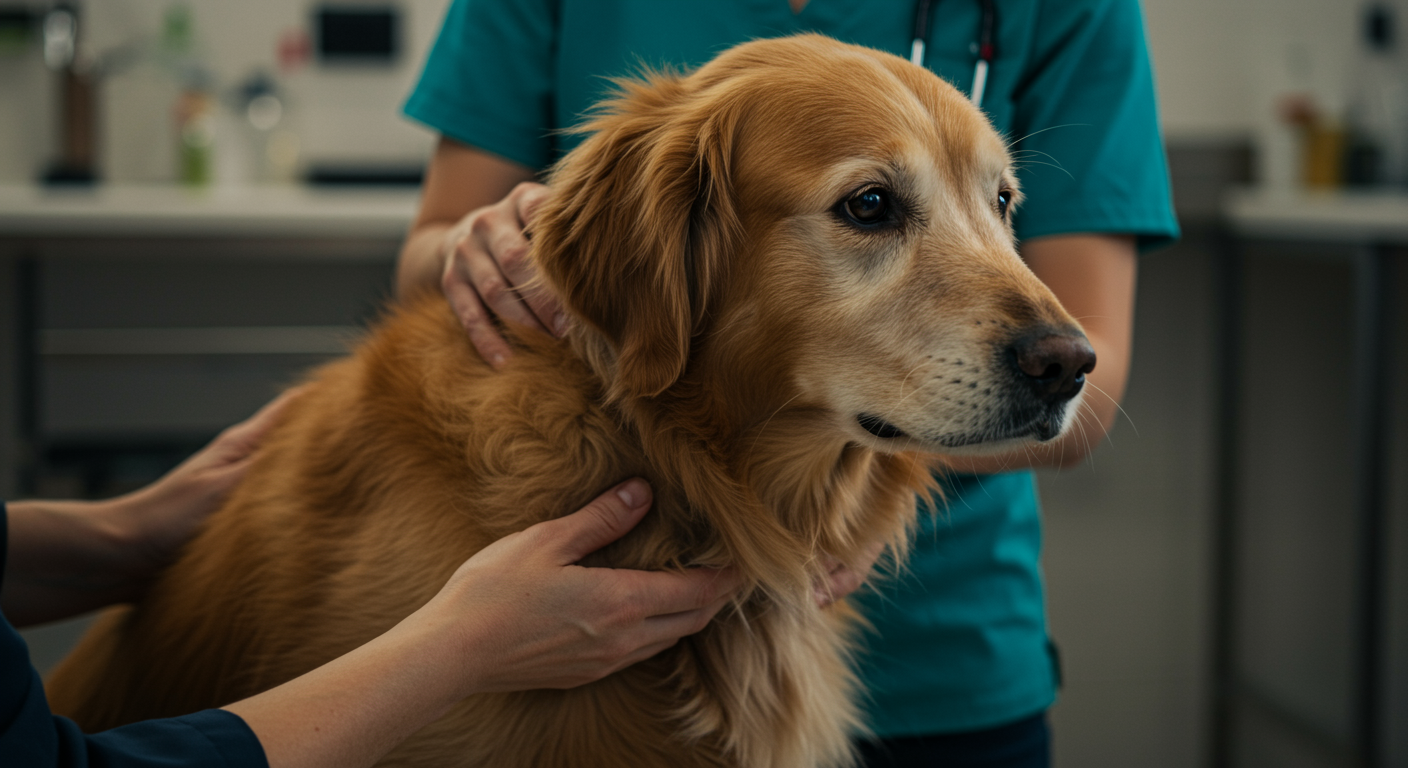Vision changes represent one of the most common yet often overlooked aspects of aging in Golden Retrievers, with studies indicating that over 75% of senior dogs experience some degree of visual impairment by age 10. Unlike humans who readily report vision difficulties, dogs adapt remarkably well to gradual vision loss, often masking problems until they become severe. This adaptation, while testament to their resilience, means that many Golden Retrievers suffer from treatable eye conditions that go unrecognized until permanent damage occurs.
Golden Retrievers face particular vulnerability to several hereditary eye conditions that typically manifest or worsen with age, including progressive retinal atrophy, cataracts, and glaucoma. Additionally, age-related changes such as nuclear sclerosis and decreased tear production affect nearly all senior Golden Retrievers to some degree. Understanding these conditions, recognizing early warning signs, and knowing when to seek professional intervention can preserve vision and maintain quality of life throughout their golden years.
The impact of vision problems extends far beyond simple sight loss. Dogs experiencing vision difficulties may become anxious, withdrawn, or reluctant to engage in previously enjoyed activities. They might show increased dependence on familiar routines and environments, or display behavioral changes that owners mistakenly attribute to normal aging or stubbornness. Early recognition and appropriate management of vision problems can help maintain confidence, independence, and the joyful engagement with life that defines Golden Retrievers.
Understanding Canine Vision and Age-Related Changes
Normal Canine Vision Characteristics
Golden Retrievers, like all dogs, perceive the world differently than humans. Their vision is optimized for detecting movement and seeing in low light conditions, abilities that served their ancestors well as hunters and working dogs. Understanding normal canine vision helps owners recognize when changes indicate potential problems rather than normal variations.
Color Vision: Dogs see colors differently than humans, perceiving primarily blues and yellows while having difficulty distinguishing reds and greens. This dichromatic vision is normal and doesn’t change significantly with age, though overall color discrimination may become less acute in senior dogs.
Visual Acuity: Most dogs have vision equivalent to 20/75 in humans, meaning they must be 20 feet away to see what humans can see clearly at 75 feet. Golden Retrievers typically have good visual acuity compared to some other breeds, though individual variations exist.
Night Vision: Dogs excel in low-light conditions due to a reflective layer called the tapetum lucidum, which gives their eyes the characteristic “glow” in photographs. This advantage typically persists throughout life unless specific eye diseases interfere with the structures responsible for light amplification.
Peripheral Vision: Dogs have wider fields of view than humans, approximately 240 degrees compared to humans’ 180 degrees. This peripheral vision is crucial for detecting movement and maintaining spatial awareness.
Age-Related Vision Changes
Nuclear Sclerosis: This condition affects virtually all senior Golden Retrievers, causing the lens to develop a bluish-gray haze that becomes noticeable around age 6-8. Unlike cataracts, nuclear sclerosis doesn’t significantly impair vision and is considered a normal aging change.
Decreased Tear Production: Senior dogs often produce fewer tears, leading to dry eye conditions that can cause discomfort and potentially damage the corneal surface. This condition, called keratoconjunctivitis sicca (KCS), requires ongoing management to prevent complications.
Reduced Light Adaptation: Aging eyes become less efficient at adjusting to changes in lighting conditions. Senior Golden Retrievers may have difficulty transitioning from bright to dim environments or vice versa, making them hesitant to navigate areas with variable lighting.
Decreased Depth Perception: Age-related changes in the eye’s focusing ability can affect depth perception, making dogs more cautious around stairs, curbs, or uneven surfaces they previously navigated confidently.
Common Eye Conditions in Senior Golden Retrievers
Cataracts: The Most Recognized Vision Problem
Cataracts represent the most well-known eye condition affecting Golden Retrievers, though they’re often confused with the normal aging change of nuclear sclerosis. True cataracts involve clouding of the lens that significantly impairs vision and can progress to complete blindness if left untreated.
Types of Cataracts in Golden Retrievers:
- Hereditary Cataracts: Golden Retrievers are genetically predisposed to inherited cataracts that typically develop between ages 1-8
- Diabetic Cataracts: Dogs with diabetes often develop rapidly progressing cataracts due to glucose metabolism changes in the lens
- Senile Cataracts: Age-related cataracts that develop gradually in senior dogs without underlying disease
Progression Stages: Cataracts are classified by their development stage, from incipient (small areas of cloudiness) to mature (complete lens opacity). Early-stage cataracts may not significantly impact vision, while advanced cataracts can cause complete blindness.
| Stage | Visual Impact | Lens Appearance | Typical Progression | Treatment Options |
|---|---|---|---|---|
| Incipient | Minimal to none | Small cloudy areas | Months to years | Monitoring, antioxidants |
| Immature | Moderate impairment | Partial cloudiness | 6-18 months | Surgery consideration |
| Mature | Severe to complete loss | Complete opacity | 3-12 months | Surgery recommended |
| Hypermature | Complete blindness | Lens may shrink | Variable | Surgery with complications |
| Morgagnian | Blindness with inflammation | Lens liquefaction | Months to years | Surgery urgent |
Secondary Complications: Advanced cataracts can lead to lens-induced uveitis, a painful inflammatory condition that requires immediate veterinary attention. This complication can cause permanent damage even if cataracts are later surgically removed.
Progressive Retinal Atrophy (PRA)
PRA represents a group of inherited diseases that cause progressive degeneration of the retina, leading to eventual blindness. Golden Retrievers are susceptible to several forms of PRA, with symptoms typically appearing in middle to senior years.
Early Signs of PRA:
- Night blindness (difficulty seeing in dim light)
- Reluctance to go outside at dusk or dawn
- Bumping into objects in low-light conditions
- Increased reflection from the eyes (enhanced tapetal reflection)
- Dilated pupils that don’t respond normally to light
Disease Progression: PRA typically begins with loss of night vision as rod cells in the retina degenerate. Day vision follows as cone cells are affected, eventually leading to complete blindness. The progression varies by PRA type but is generally irreversible.
| PRA Type | Age of Onset | Progression Rate | Inheritance Pattern | Genetic Testing Available |
|---|---|---|---|---|
| PRA1 | 2-5 years | Slow (years) | Autosomal recessive | Yes |
| PRA2 | 3-6 years | Moderate (1-2 years) | Autosomal recessive | Yes |
| PRCD-PRA | 3-9 years | Variable | Autosomal recessive | Yes |
| Late-onset PRA | 6-12 years | Slow (years) | Complex inheritance | Limited |
Glaucoma: The Silent Vision Thief
Glaucoma involves increased pressure within the eye that damages the optic nerve and retina. This condition can develop rapidly and cause permanent vision loss within hours if not treated promptly.
Primary vs. Secondary Glaucoma:
- Primary Glaucoma: Inherited condition affecting drainage structures within the eye
- Secondary Glaucoma: Results from other eye conditions such as uveitis, lens luxation, or tumors
Warning Signs of Glaucoma:
- Cloudy or hazy cornea
- Enlarged eye appearance
- Excessive tearing or discharge
- Squinting or keeping the eye closed
- Behavioral changes indicating pain
- Loss of appetite or lethargy
Emergency Nature: Glaucoma constitutes a veterinary emergency requiring immediate treatment to preserve vision and relieve pain. Delayed treatment often results in permanent blindness and may necessitate eye removal.
Recognizing Early Warning Signs
Behavioral Changes Indicating Vision Problems
Golden Retrievers experiencing vision difficulties often display subtle behavioral changes before obvious vision loss becomes apparent. Recognizing these early signs allows for prompt veterinary evaluation and potential intervention.
Navigation Hesitancy: Dogs with developing vision problems may become hesitant about navigating familiar environments, particularly in low-light conditions. They might pause before going up or down stairs, hesitate at doorways, or show reluctance to enter unfamiliar areas.
Increased Clinginess: Some Golden Retrievers become more dependent on their owners when vision begins to decline, staying closer during walks or showing anxiety when left alone in unfamiliar environments.
Activity Level Changes: Dogs may reduce their activity levels or show less enthusiasm for games involving visual tracking, such as fetch or frisbee. They might prefer activities that rely more heavily on scent or hearing.
Sleep Pattern Alterations: Vision problems can affect sleep patterns, with some dogs becoming more restless at night or preferring to sleep in well-lit areas.
Physical Signs to Monitor
Eye Appearance Changes: Regular observation of your Golden Retriever’s eyes can reveal important changes that warrant veterinary attention.
| Physical Sign | Possible Conditions | Urgency Level | Action Required |
|---|---|---|---|
| Cloudy/hazy cornea | Glaucoma, corneal disease | High | Immediate vet visit |
| White/gray lens opacity | Cataracts, nuclear sclerosis | Moderate | Schedule exam |
| Red, inflamed eyes | Uveitis, conjunctivitis | High | Same-day vet visit |
| Excessive tearing | Blocked tear ducts, irritation | Low-Moderate | Monitor, schedule exam |
| Enlarged eye appearance | Glaucoma | Very High | Emergency vet visit |
| Discharge (green/yellow) | Infection | Moderate-High | Vet visit within 24 hours |
Pupil Response Testing: Simple at-home tests can help assess pupil function, though they don’t replace professional examination.
Behavioral Assessment Checklist:
- Does your dog hesitate before jumping onto furniture?
- Are they more cautious on stairs, especially in dim lighting?
- Do they bump into moved furniture or new obstacles?
- Have they become less interested in visual games?
- Do they seem more anxious in unfamiliar environments?
- Are they reluctant to go outside at dusk or dawn?
Diagnostic Approaches and Professional Evaluation
Comprehensive Eye Examinations
Professional eye examinations for senior Golden Retrievers should include multiple components to assess overall eye health and detect specific conditions.
Visual Assessment: Veterinarians evaluate visual responses using various techniques including menace response testing, obstacle course navigation, and pupil light reflexes. These tests help determine the extent of vision loss and identify which structures may be affected.
Intraocular Pressure Measurement: Tonometry measures pressure within the eye to screen for glaucoma. Normal canine intraocular pressure ranges from 10-25 mmHg, with pressures above 25 mmHg indicating potential glaucoma.
Ophthalmoscopy: Direct examination of internal eye structures allows visualization of the retina, optic nerve, and blood vessels. This examination can detect retinal degeneration, optic nerve damage, and vascular changes associated with various eye diseases.
Slit Lamp Examination: This specialized equipment provides detailed views of the cornea, anterior chamber, iris, and lens, allowing detection of subtle changes that might not be visible with standard examination techniques.
Advanced Diagnostic Testing
Electroretinography (ERG): This test measures electrical responses of the retina to light stimulation, providing objective assessment of retinal function. ERG is particularly valuable for diagnosing PRA and monitoring disease progression.
Gonioscopy: This technique evaluates drainage angles within the eye to assess glaucoma risk and determine appropriate treatment strategies.
Ocular Ultrasound: When cataracts or other opacities prevent visualization of internal structures, ultrasound can assess retinal health and detect masses or other abnormalities.
Genetic Testing: DNA tests are available for several inherited eye conditions affecting Golden Retrievers, including various forms of PRA and hereditary cataracts.
Treatment Options and Management Strategies
Medical Management
Glaucoma Treatment: Multiple medications can reduce intraocular pressure and preserve vision when used promptly and consistently.
| Medication Class | Mechanism | Common Drugs | Administration | Side Effects |
|---|---|---|---|---|
| Carbonic Anhydrase Inhibitors | Reduce fluid production | Dorzolamide, Brinzolamide | 2-3 times daily | Mild stinging, taste changes |
| Beta-blockers | Reduce fluid production | Timolol | 2 times daily | Respiratory effects (rare) |
| Prostaglandin Analogs | Increase fluid drainage | Latanoprost | 1-2 times daily | Iris color changes |
| Osmotic Agents | Emergency pressure reduction | Mannitol (IV) | As needed | Dehydration risk |
Dry Eye Management: Artificial tears, cyclosporine, or tacrolimus can help manage keratoconjunctivitis sicca and prevent corneal damage.
Anti-inflammatory Treatment: Topical or systemic anti-inflammatory medications may be necessary for uveitis or other inflammatory eye conditions.
Surgical Interventions
Cataract Surgery: Phacoemulsification with intraocular lens implantation can restore vision in dogs with cataracts. Success rates are high when performed by experienced veterinary ophthalmologists, with over 90% of dogs regaining functional vision.
Glaucoma Surgery: Various surgical procedures can help manage glaucoma when medical treatment is insufficient. Options include laser therapy, drainage implants, or cyclodestructive procedures.
Enucleation: In cases of painful, blind eyes that don’t respond to other treatments, surgical removal may be the most humane option to eliminate pain and improve quality of life.
Environmental Adaptations for Vision-Impaired Dogs
Home Modifications
Creating a vision-friendly environment helps Golden Retrievers with eye problems maintain independence and confidence.
Lighting Improvements: Consistent, adequate lighting throughout the home helps dogs with partial vision navigate safely. Motion-activated lights can provide illumination when needed without requiring human intervention.
Obstacle Management: Maintaining consistent furniture placement and removing unnecessary obstacles creates predictable pathways for vision-impaired dogs. When changes are necessary, introduce them gradually with guidance.
Safety Measures: Baby gates can prevent access to stairs or other potentially dangerous areas when supervision isn’t available. Non-slip rugs provide secure footing and can serve as tactile landmarks.
Scent Markers: Using different scents to mark important locations (food bowls, doors, favorite resting spots) helps dogs navigate using their enhanced sense of smell.
Exercise and Activity Modifications
Leash Walking: Dogs with vision problems should be kept on leash during walks to prevent injuries from unseen obstacles. Choose familiar routes with predictable terrain.
Swimming: This low-impact exercise remains safe and enjoyable for many vision-impaired Golden Retrievers, though supervision is essential.
Mental Stimulation: Puzzle toys, scent work, and training exercises that don’t rely heavily on vision help maintain mental engagement and prevent boredom.
Prevention and Early Intervention
Genetic Screening and Breeding Considerations
Pre-breeding Testing: Responsible breeders should conduct genetic testing for known eye conditions and obtain annual eye examinations from veterinary ophthalmologists.
Puppy Eye Examinations: Early eye examinations can detect congenital conditions and establish baseline health records for future reference.
Routine Monitoring
Annual Eye Exams: Senior Golden Retrievers should receive comprehensive eye examinations annually, or more frequently if risk factors are present.
Home Monitoring: Regular observation of eye appearance and behavior helps detect changes that warrant professional evaluation.
Photography Documentation: Taking regular photos of your dog’s eyes can help document changes over time and assist veterinarians in tracking disease progression.
Living with Vision Loss
Quality of Life Considerations
Many Golden Retrievers adapt remarkably well to vision loss, maintaining good quality of life with appropriate support and environmental modifications. The key is understanding that dogs rely heavily on their other senses and can learn to navigate effectively using hearing, smell, and spatial memory.
Adaptation Timeline: Most dogs require 2-6 months to fully adapt to vision loss, with younger dogs typically adjusting more quickly than seniors. Patience and consistent support during this transition period are crucial.
Maintaining Routine: Consistent daily routines help vision-impaired dogs feel secure and confident. Regular feeding times, exercise schedules, and sleeping arrangements provide structure and predictability.
Social Interaction: Vision loss doesn’t diminish a dog’s need for social interaction and affection. Many vision-impaired Golden Retrievers remain playful, affectionate, and engaged with their families.
Support Strategies
Voice Commands: Teaching and reinforcing verbal cues helps vision-impaired dogs navigate safely. Commands like “step up,” “step down,” and “careful” can prevent injuries and build confidence.
Physical Guidance: Gentle physical guidance using hands or a target stick can help dogs learn new routes or navigate obstacles safely.
Companion Animals: Some vision-impaired dogs benefit from the guidance of other pets in the household, though this relationship should develop naturally rather than being forced.
The Journey Through Changing Vision
Vision problems in aging Golden Retrievers represent a significant but manageable challenge that requires understanding, patience, and proactive care. While some conditions like PRA may be irreversible, many eye problems can be successfully treated or managed when detected early. The key lies in regular monitoring, prompt professional evaluation of concerning changes, and appropriate environmental adaptations that support dogs through vision changes.
The remarkable adaptability of Golden Retrievers means that even significant vision loss doesn’t necessarily diminish their quality of life or their capacity for joy and companionship. With proper support, many vision-impaired dogs continue to enjoy walks, play, training, and all the activities that make life meaningful. Their enhanced reliance on other senses often reveals new dimensions of their intelligence and resilience.
Success in managing vision problems requires partnership between dedicated owners and knowledgeable veterinary professionals who understand both the medical aspects of eye disease and the practical challenges of living with vision-impaired pets. Through early detection, appropriate treatment, and thoughtful environmental modifications, most Golden Retrievers with eye problems can maintain excellent quality of life throughout their senior years.
Your commitment to monitoring and supporting your Golden Retriever’s vision health demonstrates the depth of your care and understanding of their changing needs. By staying vigilant for early warning signs, seeking prompt professional care when needed, and making appropriate adaptations to support their changing abilities, you ensure that vision problems don’t prevent your beloved companion from continuing to experience the joy, comfort, and love that define the special bond between Golden Retrievers and their devoted families.

Rafael Souza is a digital marketing strategist and lifelong dog enthusiast. Passionate about Golden Retrievers, he shares practical, research-based tips to help owners provide healthier and happier lives for their furry companions.





